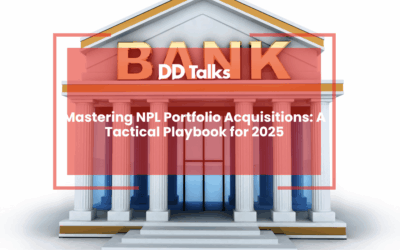Essential Insights for Distressed Real Estate Investors
- NPL real estate investing requires specialized knowledge of both debt markets and property valuation, targeting higher returns (15-25% IRR) compared to traditional real estate investments (5-10%).
- Successful distressed property evaluation demands a multifaceted approach including loan documentation review, comprehensive property assessment, and sophisticated financial modeling.
- Effective risk management strategies include thorough legal due diligence, geographic diversification, maintaining higher cash reserves, and implementing robust project management systems.
- Leading NPL funds maintain flexibility in their workout approaches, develop in-house value-add capabilities, and adjust their investment focus based on evolving market conditions.
- Investors can access distressed real estate through multiple channels including direct investment, private equity funds, debt funds, and publicly traded REITs, each offering different risk-return profiles.
- Building a successful distressed real estate portfolio requires strategic diversification across property types and regions, phased capital deployment, and active performance monitoring.
Table of Contents
- Understanding Distressed Real Estate and NPL Portfolios
- How NPL Real Estate Investing Differs from Traditional Approaches
- Sourcing and Evaluating NPL REO Properties: A Strategic Guide
- Risk Management Strategies for Distressed Real Estate Investments
- NPL Property Management: Turning Challenges into Opportunities
- Key Strategies Employed by Successful Real Estate NPL Funds
- How Can Investors Profit from Distressed Real Estate Markets?
- Building Your Distressed Real Estate Investment Portfolio
Understanding Distressed Real Estate and NPL Portfolios
Distressed real estate represents properties that are under financial or legal pressure, often resulting from the owner’s inability to meet mortgage obligations. These assets typically emerge when economic downturns strain property owners’ finances, leading to non-performing loans (NPLs) on banks’ balance sheets. In the European banking landscape, NPLs have become a significant concern, particularly in markets like Italy, Greece, and Spain following the 2008 financial crisis and subsequent economic challenges.
NPL portfolios consist of loans where borrowers have failed to make scheduled payments for an extended period (usually 90+ days). When these loans are secured by real estate, they create opportunities for investors to acquire properties at substantial discounts to market value. European banks, under regulatory pressure to clean up their balance sheets, often sell these NPL portfolios to specialised investors who have the expertise to manage and extract value from these complex assets.
The distressed real estate market operates in cycles, typically expanding during economic downturns and contracting during periods of growth. Understanding these market cycles is crucial for timing investments effectively. NPL portfolios may include various property types—residential, commercial, industrial, or mixed-use—each presenting unique challenges and opportunities for value creation through proper management and rehabilitation strategies.
How NPL Real Estate Investing Differs from Traditional Approaches
NPL real estate investing fundamentally diverges from traditional property investment in several critical aspects. While conventional real estate investors typically purchase properties directly through standard market channels, NPL investors acquire distressed debt secured by real estate, potentially gaining control of the underlying assets through foreclosure or negotiated settlements. This indirect acquisition pathway requires specialised knowledge of both debt markets and property valuation.
The due diligence process for NPL investments is considerably more complex than for traditional real estate. Investors must evaluate not only the physical condition and market value of properties but also the legal status of loans, potential title issues, occupancy challenges, and various encumbrances that might affect value. This complexity creates barriers to entry that limit competition but also necessitates sophisticated analytical capabilities.
Return profiles also differ significantly. Traditional real estate typically generates steady income with moderate appreciation, while distressed real estate investments often follow a J-curve pattern—initial negative returns during the workout phase followed by substantial gains upon resolution. NPL investments generally target higher returns (often 15-25% IRR) to compensate for increased risk and complexity compared to the 5-10% typically expected from conventional real estate investments.
The timeline for realising returns also varies dramatically. Traditional property investments might span years or decades, while NPL investments typically have a defined resolution horizon of 2-5 years, after which the assets are either sold or repositioned within a more traditional investment framework. This accelerated timeline requires more active management and specialised expertise in unlocking value through NPL portfolios.
Sourcing and Evaluating NPL REO Properties: A Strategic Guide
Sourcing NPL REO (Real Estate Owned) properties requires navigating multiple channels that differ from traditional real estate acquisition methods. In Europe, primary sources include direct purchases from financial institutions, specialised NPL trading platforms, auctions conducted by courts or insolvency administrators, and secondary market acquisitions from other investors. Building relationships with banks’ asset management departments can provide early access to portfolios before they reach public markets.
Evaluation of these assets demands a multifaceted approach. The first critical step involves thorough loan documentation review, examining the original loan terms, security agreements, and enforcement rights. This legal assessment must be complemented by comprehensive property evaluation, including physical condition assessment, occupancy status, and potential environmental issues. Market analysis should focus not just on current values but on recovery potential over the intended holding period.
Pricing distressed assets requires sophisticated modelling that accounts for:
- Acquisition costs including legal fees and transfer taxes
- Holding costs during the workout period
- Capital expenditure requirements for rehabilitation
- Time value of money considering extended resolution periods
- Exit strategies and associated transaction costs
Successful investors typically establish minimum criteria for NPL acquisitions, including loan-to-value ratios below 70%, clear legal pathways to ownership, and properties in markets with sufficient liquidity for eventual disposition. They also develop standardised evaluation frameworks that can be applied consistently across multiple potential acquisitions, enabling rapid assessment of numerous opportunities in this fast-moving market segment.
Risk Management Strategies for Distressed Real Estate Investments
Effective risk management is paramount when navigating the complex terrain of distressed real estate investments. Legal risks represent perhaps the most significant challenge, as NPL portfolios often come with complicated title issues, potential borrower litigation, and regulatory compliance requirements. Mitigating these risks requires thorough legal due diligence and often the establishment of contingency reserves for unexpected legal proceedings. Engaging specialised legal counsel with expertise in local foreclosure and property laws is essential, particularly when operating across different European jurisdictions with varying legal frameworks.
Market risks in distressed real estate investing can be more pronounced than in traditional property investments. The assets often require significant holding periods during which market conditions may shift dramatically. Prudent investors implement hedging strategies, maintain diversification across property types and geographic regions, and establish clear exit triggers based on predefined performance metrics. Stress testing investment models against various economic scenarios helps quantify potential downside risks.
Operational risks emerge from the intensive management requirements of distressed properties. These assets frequently require substantial rehabilitation, tenant issues resolution, and ongoing maintenance challenges. Building a reliable network of property managers, contractors, and service providers is crucial for addressing these operational concerns efficiently. Implementing robust project management systems with regular reporting and oversight mechanisms helps maintain control over renovation timelines and budgets.
Financial risk management involves careful structuring of acquisition financing, maintaining adequate liquidity reserves, and establishing conservative loan-to-value ratios. Successful distressed real estate investors typically maintain higher cash reserves than traditional property investors to address unexpected expenses and capitalise on emerging opportunities within their portfolios.
NPL Property Management: Turning Challenges into Opportunities
NPL property management presents unique challenges that require specialised approaches distinct from conventional property administration. When investors acquire properties through NPL resolution, they often inherit assets with deferred maintenance, occupancy issues, and administrative complications. The initial stabilisation phase is critical and typically involves comprehensive property assessment, addressing immediate safety concerns, and establishing basic operational functionality.
Tenant management in distressed properties requires particular sensitivity. Properties may have occupants with expired leases, unauthorised residents, or tenants who have experienced disruption during the foreclosure process. Successful NPL property managers develop clear communication protocols and often implement tenant retention programmes where appropriate, recognising that maintaining occupancy can be more cost-effective than finding new tenants after property rehabilitation.
Renovation strategies for distressed assets must balance cost control with value creation. Rather than pursuing comprehensive upgrades immediately, experienced managers typically implement phased improvement plans that prioritise issues affecting rentability and safety. This staged approach allows for cash flow generation while gradually enhancing property value. Standardising renovation specifications across multiple properties can create economies of scale and improve cost predictability.
Technology plays an increasingly important role in effective NPL property management. Digital platforms for maintenance tracking, tenant communication, and performance monitoring enable managers to handle larger portfolios efficiently. Data analytics help identify patterns across properties, optimising resource allocation and highlighting both problems and opportunities within the portfolio. This technology-enabled approach transforms what was traditionally a reactive management challenge into a proactive value creation opportunity.
Key Strategies Employed by Successful Real Estate NPL Funds
Successful real estate NPL funds employ distinctive strategies that differentiate them in this specialised market segment. Portfolio diversification represents a foundational approach, with leading funds balancing their acquisitions across various property types, geographic regions, and distress levels. This diversification mitigates concentration risk while allowing funds to capitalise on their expertise in specific niches. Many European NPL funds maintain a primary focus on their home markets while selectively expanding into adjacent countries where they understand local legal frameworks.
Workout strategies vary based on the specific circumstances of each asset. The most sophisticated funds maintain flexibility in their approach, employing:
- Loan restructuring when borrowers have viable recovery plans
- Discounted payoff negotiations to achieve rapid resolution
- Foreclosure and property repositioning when necessary
- Joint ventures with original borrowers who possess operational expertise
Value-add capabilities represent another critical success factor. Leading NPL funds develop in-house expertise or strategic partnerships for property rehabilitation, repositioning, and management. This vertical integration allows them to capture additional margin throughout the value chain rather than simply acquiring distressed debt and selling to other investors. The ability to execute complex business plans for challenging properties creates significant competitive advantage.
Timing strategies also distinguish top-performing funds. Rather than attempting to time market cycles perfectly, successful managers maintain consistent acquisition discipline while adjusting their target property types and geographic focus based on evolving market conditions. They recognise that distressed opportunities exist in all market phases but require different approaches during various economic cycles. This counter-cyclical perspective enables them to acquire assets when competition is limited and sell into strength when markets recover.
How Can Investors Profit from Distressed Real Estate Markets?
Investors can access distressed real estate opportunities through multiple channels, each offering different risk-return profiles and capital requirements. Direct investment represents the most straightforward approach, where qualified investors purchase individual distressed properties or small portfolios. This method provides maximum control but requires substantial expertise in property evaluation, rehabilitation, and management. For investors with sufficient capital (typically €1 million minimum), this approach can generate returns of 15-25% on individual projects.
Private equity real estate funds specialising in distressed assets offer a more diversified entry point. These vehicles typically require minimum investments of €100,000-€250,000 and provide professional management and built-in diversification across multiple properties. Leading European distressed real estate funds have historically delivered net IRRs of 12-18%, though performance varies significantly based on vintage year and investment strategy.
Real estate debt funds focused on NPLs represent another avenue, allowing investors to participate in the distressed market without direct property ownership. These funds acquire non-performing loans at discounts to face value and generate returns through loan resolution strategies. This approach typically offers somewhat lower returns (10-15% IRR) but with reduced operational complexity compared to direct property ownership.
For investors seeking more liquid options, publicly traded real estate investment trusts (REITs) that include distressed assets in their portfolios provide market access with daily liquidity. While returns may be diluted compared to dedicated distressed strategies, this approach requires minimal capital commitment and offers immediate diversification. Several European REITs have developed expertise in acquiring and rehabilitating distressed assets while providing investors with regular income distributions.
Building Your Distressed Real Estate Investment Portfolio
Constructing a robust distressed real estate portfolio requires strategic planning and disciplined execution. Begin by establishing clear investment parameters, including target property types, geographic focus, and distress level preferences. Successful portfolios typically maintain balance across these dimensions rather than concentrating exclusively on a single property type or region. For European investors, starting with familiar domestic markets before expanding internationally often proves prudent, as local knowledge provides competitive advantage in distressed asset evaluation.
Capital allocation strategies should reflect both opportunity availability and risk management principles. Many experienced investors adopt a phased deployment approach, committing capital gradually to avoid concentration in a single vintage period. This strategy allows for learning and adjustment as market conditions evolve. Maintaining liquidity reserves (typically 15-20% of committed capital) provides flexibility to capitalise on unexpected opportunities or address challenges within existing investments.
Portfolio construction should incorporate complementary assets that perform differently across economic cycles. For instance, combining residential properties (which typically offer stability) with opportunistic commercial assets (which may provide higher upside) creates natural hedging within the portfolio. Similarly, balancing properties requiring extensive rehabilitation with more stabilised assets generates both immediate cash flow and long-term appreciation potential.
Performance monitoring and active management distinguish successful distressed real estate portfolios. Establish clear metrics for each asset, including target rehabilitation timelines, occupancy goals, and projected cash flow milestones. Regular portfolio reviews should assess not only individual asset performance but also changing market conditions that might warrant strategic adjustments. The most successful investors maintain flexibility to modify business plans for specific properties while adhering to their overall investment discipline and diversification principles.
Frequently Asked Questions
What are NPL portfolios in real estate?
NPL (Non-Performing Loan) portfolios in real estate consist of loans where borrowers have failed to make scheduled payments for 90+ days. These loans are secured by real estate properties, creating opportunities for investors to acquire assets at substantial discounts to market value. European banks often sell these portfolios to clean up their balance sheets, particularly in markets like Italy, Greece, and Spain.
How do returns on distressed real estate compare to traditional investments?
Distressed real estate investments typically target higher returns (15-25% IRR) compared to conventional real estate investments (5-10%). They follow a J-curve pattern with initial negative returns during the workout phase followed by substantial gains upon resolution. This higher return potential compensates for increased risk, complexity, and the specialized expertise required to manage these assets.
What are the main risks when investing in distressed real estate?
The main risks in distressed real estate investing include legal risks (title issues, borrower litigation), market risks (extended holding periods during market shifts), operational risks (rehabilitation challenges, tenant issues), and financial risks. Successful investors mitigate these through thorough due diligence, diversification across property types and regions, maintaining adequate liquidity reserves, and implementing robust property management systems.
How can individual investors access distressed real estate opportunities?
Individual investors can access distressed real estate through: direct investment in individual properties (€1M+ typically required), private equity real estate funds (€100,000-€250,000 minimum investments), real estate debt funds focused on NPLs, or publicly traded REITs that include distressed assets. Each option offers different risk-return profiles, liquidity characteristics, and capital requirements.
What strategies do successful NPL property managers implement?
Successful NPL property managers implement phased improvement plans prioritizing issues affecting rentability and safety, develop clear tenant communication protocols, standardize renovation specifications across properties to create economies of scale, and leverage technology platforms for maintenance tracking and performance monitoring. This transforms reactive management challenges into proactive value creation opportunities.
How does the due diligence process differ for NPL investments?
Due diligence for NPL investments is considerably more complex than traditional real estate. Investors must evaluate the physical condition and market value of properties alongside the legal status of loans, potential title issues, occupancy challenges, and various encumbrances. This requires examining loan documentation, security agreements, enforcement rights, and conducting comprehensive property assessments including environmental issues.




0 Comments